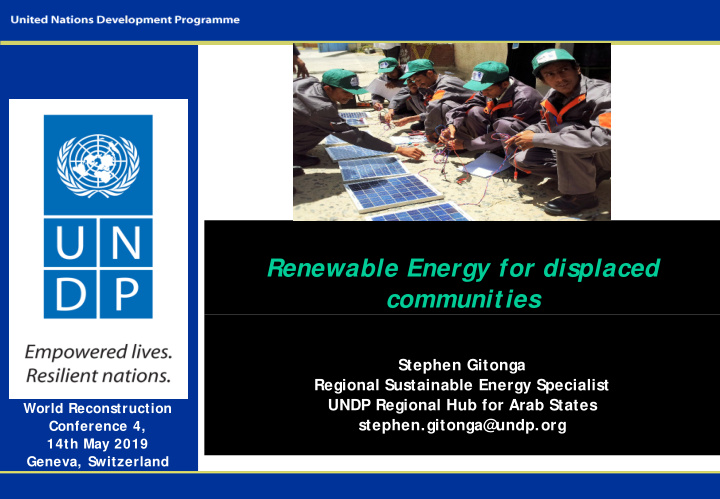



Renewable Energy for displaced communities Stephen Gitonga Regional Sustainable Energy Specialist UNDP Regional Hub for Arab States World Reconstruction stephen.gitonga@undp.org Conference 4, 14th May 2019 Geneva, Switzerland
The UN Development Programme UNDPs Strategic Plan (2018-2021) has a key focus on climate action and closing the energy gap for poor and crisis affected communities. UNDP helps countries transition to risk informed, low-carbon, climate resilient forms of energy so as to be more resilient to crises, and helping ensure access to sustainable energy for communities when a crisis does hit. UNDP is the UNs largest provider of grant assistance for climate action, with $3 billion of projects today on climate mitigation and adaptation in 140 countries. 2
Development challenges to SDG achievement in the Arab region Risk of reduced 7% of the world’s food productivity 20 most water- and water stressed availability by 20% countries by 2050 Renewable energy in the energy mix, despite highest solar radiation levels 14 Displacement from conflict and climate 2-5 ˚ Temperature rising faster than world 2.1% average Of world’s famine average annual precipitation 2007-2017 saw 1 ˚ worst drought Conflict in 7 out of 18 in 1000 years countries
The Arab region in relation to energy for displaced communities • Poverty rates in the region are The Arab region has expanding in countries in fragile and experienced dramatic crises crisis contexts owing to rising levels of events in its history conflict and displacement. • The Middle East and Africa • Recognising that it’s a multi- regions host close to 70% of all dimensional development challenge, the 68.5 million world targeted actions to integrate energy in displaced persons. crisis recovery is important to ensure that nobody is left behind. 4
From 2007-2017, the region saw one of its most severe drought cycles in the last 1000 years, triggering large internal displacement, famine, rise of poverty, and social disruption and instability across the entire Arab region
Countries impacted by protracted crisis in the Arab region • Ten countries impacted by crisis. Yemen, Syria, Libya, Somalia, Iraq, Sudan, Palestine. • Lebanon, Djibouti and Jordan are hosting a big number of refugees compared to their populations exerting pressure to energy resources. • Fragile or countries in crisis context are unable to have sufficient energy for the general population as well as for hosted displaced communities . 6
Role of Energy in crisis context Energy is about inclusivity, leaving no one behind as an enabler for long-term cost effective solution to recovery from : • natural disasters • climate change induced impacts & shocks (droughts, famine, floods) • crisis impacts induced by protracted conflicts
Risk-informed Approach to e nergy planning A risk-informed approach to planning for energy and recovery should ensure that actions are taken to improve ability to withstand crises, cope with events, recover sustainably and quickly. After an event Prior to an event During an event Actions to recover Actions to prevent Ability to cope with sustainably and disruptions from crisis as it unfolds quickly shocks 8
Integrating Energy considerations in crisis context -Decentralised Entry points -Off-grid options -South-south Downstream Downstream actions: Deploying energy experiences Innovative Deployment of solutions to broader Actions -Affordability decentralized energy development goals. -Easy to solutions for health, Examples in Sudan, manage, education, Yemen, Palestine, maintain and agriculture, Somalia , Iraq, etc. operate businesses etc. Energy in crisis context Upstream actions: filling policy gaps S upport to integrate policy support in the sustainable energy including de-risking integration of solutions into national investments, enables Upstream sustainable crisis response plans accelerated policy energy into national partners in implementation of support national crisis Jordan and Lebanon, NDCs in fragile response and S yria crisis countries. resilience plans 9
Importance of Partnerships S DG Climate Facility Climate Action for Human S ecurity 2019-2022; $7 million It will provide Technical Assistance to crisis countries to scale up energy for recovery, both at upstream and downstream levels.
Leaving no one behind: Inclusive recovery responses Dedicated focus on communities affected by converging disastrous forces of climate change, conflict and displacement. integrating climate integrating energy action into crisis responses into crisis prevention policies to response and recovery prevent climate investments to help induced conflict and conflict-affected displacement communities ‘build-back better’ and sustainably Empowered communities Resilient ecosystems
Pre-requisites for e nergy investments in a crisis context for displaced communities Strong global, regional and local partnerships that promote integration of long term sustainable energy actions for crisis recovery • Innovative business models • Inclusive and innovative financing • Deployment of technologies • Engagement of the private sector • Partnerships Responses that allow continuous transition from humanitarian to development trajectory . 12
Thank you Stephen Gitonga Regional Sustainable Energy Specialist UNDP Regional Hub for Arab States (stephen.gitonga@undp.org)
Recommend
More recommend